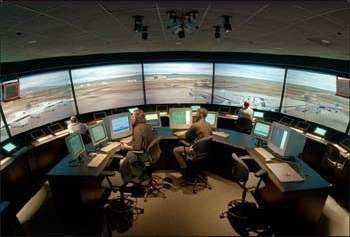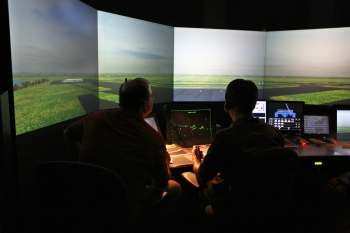Thu, Feb 07, 2008
Will Deploy Sims To 19 Airports, OKC Training Center
The Federal Aviation Administration (FAA) announced Wednesday it
will deploy new air traffic tower simulators to 19 locations around
the country to help train thousands of new air traffic controllers
in an operational environment that is interactive and provides
realistic scenarios.

The new simulators will be deployed over the next 18 months at
the following towers: John F. Kennedy (JFK); Los Angeles (LAX);
Oakland (OAK); Washington Reagan National (DCA); Dallas Fort-Worth
(DFW); Atlanta (ATL); Denver (DEN); Philadelphia (PHL); Cincinnati
(CVG); Cleveland (CLE); San Antonio (SAT); Memphis (MEM); Honolulu
(HNL); Orlando (MCO); Charlotte (CLT); Minneapolis (MSP); Boston
(BOS); and Newport News (PHF). The FAA will install an additional
six simulators at the FAA Academy in Oklahoma City (OKC).
 "We’re making sure that the
latest technology is part of the training regimen," said Bobby
Sturgell, the FAA’s acting administrator. "Controlling
traffic is a demanding job, and experience tells us that real-life
training scenarios make a critical difference. Deploying simulators
to such key locations as JFK will help us maximize our training
program."
"We’re making sure that the
latest technology is part of the training regimen," said Bobby
Sturgell, the FAA’s acting administrator. "Controlling
traffic is a demanding job, and experience tells us that real-life
training scenarios make a critical difference. Deploying simulators
to such key locations as JFK will help us maximize our training
program."
The FAA has been using tower simulators for training in Chicago,
Miami, Phoenix and Ontario, CA since 2006. In late December 2007,
the FAA awarded a contract to Adacel Systems, Incorporated of
Orlando, FL to provide another 24 simulators. Adacel, Inc.
developed the FAA’s original four prototype systems.
The Tower Simulation System (TSS) includes a large, graphic
depiction of the airfield and the area around the airport and can
be adjusted to depict different weather conditions and times of the
day. The screen showing the airfield wraps around the
student’s position to replicate windows of an actual air
traffic tower.
The simulator provides synthetic voice response and voice
recognition to allow the student to direct and receive responses as
they would in the tower. At the same time, the voice recognition
system interprets the student’s commands and translates them
into actual aircraft movements depicted on the screen of the
airfield layout.

The simulator system does not interact with actual air traffic
control operational systems and poses no threat to service
interruption. The system creates an entirely new environment that
operates away from and independently of ongoing air traffic
operations. It realistically replicates operations that enable
training in an absolutely safe environment.
More News
Aero Linx: The International Civil Aviation Organization (ICAO) The International Civil Aviation Organization (ICAO) is a United Nations agency which helps 193 countries to coopera>[...]
About 25 Days (9.3 Hours) Before The Accident, The Airframe Was Modified With Different Landing Gear Legs, Wheels, And Brakes Analysis: The pilot reported that during the landing r>[...]
Dave Juwel's Aviation Marketing Stories ITBOA BNITBOB ... what does that mean? It's not gibberish, it's a lengthy acronym for "In The Business Of Aviation ... But Not In The Busine>[...]
“Over 2025, Vertical has shown that when we set targets, we deliver. Whilst maintaining our industry-leading capital efficiency, we are not only demonstrating all piloted fli>[...]
Aero Linx: Air Medical Physician Association (AMPA) The Air Medical Physician Association (AMPA) is the largest professional organization of physicians dedicated to rotor wing (hel>[...]
 ANN's Daily Aero-Linx (11.06.25)
ANN's Daily Aero-Linx (11.06.25) NTSB Final Report: Champion 7GC
NTSB Final Report: Champion 7GC Aero-FAQ: Dave Juwel's Aviation Marketing Stories -- ITBOA BNITBOB
Aero-FAQ: Dave Juwel's Aviation Marketing Stories -- ITBOA BNITBOB Aero-News: Quote of the Day (11.06.25)
Aero-News: Quote of the Day (11.06.25) ANN's Daily Aero-Linx (11.06.25)
ANN's Daily Aero-Linx (11.06.25)





